Chapter 1, Part 20
Our driver who picked us up from Bhaktapur tried to reach our hotel using the number I gave him earlier. He tried several times, to no avail, until he decided to just ask the locals for direction. We were heading to Thamel, an area in the Nepalese capital synonymous with hippies and backpackers, which I imagined to look similar with Khao San Road in Bangkok. However Thamel turned out to be more dense than I thought where multi-story buildings were squeezed next to each other, leaving no space for anything in between except for narrow streets and alleys where jumbled electric cables hung overhead, right above the steady stream of passers by.
Endless rows of souvenir shops, bookstores, restaurants, travel agents, hiking apparel stores, money changers, convenience stores, and hotels filled every available space in Thamel. In 2013, tourism contributed to more than 8% of Nepal’s GDP and 7% of all jobs in the country, and combined with other services industries they account for more than half of the country’s GDP. Obviously the country’s economy was severely affected by the April 2015 earthquake, and the months-long fuel crisis only exacerbated the already dire situation.
We finally arrived at our hotel, hidden from the ever-busy and crowded main street of Thamel. A statue of the Buddha and colorful Tibetan prayer flags welcomed us as we entered the hotel, and faces of friendly Nepalese staff greeted us at the reception desk. There is no better thing than seeing kind and sincere smiles upon arriving to such a chaotic place like Kathmandu.
According to Swayambhu Purana, a Buddhist scripture about the history and legend of the Kathmandu Valley, Manjushri (a boddhisattva in Mayahana Buddhism and a deity in Tibetan Buddhism) drained a lake in the valley using his sword. A hill then emerged, on which Swayambhunath was later erected. Highly revered by both Buddhists and Hindus, the temple is considered one of the most sacred sites in Nepal.
As we climbed up the stairs to reach the stupa, resident simians were frolicking around a multitude of miniatures of the Buddha, indifferent of the wary pilgrims and visitors. On top of the hill, a white stupa crowned with multiple layers of gilded ornaments was a prominent sight in the middle of Kathmandu’s grayish, polluted air. Underneath the bottom layer of the pinnacle, four identical pairs of eyes of the Buddha gazed with compassion toward all four directions. Around the stupa’s base, sets of copper prayer wheels gleamed softly under the morning sun.
In the 15th century, Kathmandu saw the rise of the Malla dynasty, who also started their reign in Bhaktapur, with Ratna Malla as its first king. However the construction of Hindu temples in Newar architectural style only began almost one century later under the rule of Mahendra Malla, including the imposing Taleju Temple, dedicated to the patron goddess of the Mallas.
More than half a century later, Pratap Malla began an era of prolific artistic development in the city, with the beautification of his palace, the addition of decorative elements to existing temples, and the construction of more temples in Newar style, essentially bringing the city’s Durbar Square to the center of the local people’s universe.
Today many buildings within the Durbar Square proper still stand, although a handful of ancient temples and pavilions did not survive the devastating April 2015 earthquake. Kasthamandap, from which the city’s current name was derived, unfortunately was one of the less fortunate structures, leaving only rubble on the ground where it once proudly stood. On one corner of the square, a seemingly out of place European-inspired building, built long after the end of the Mallas, only suffered minor damage.
Kathmandu Durbar Square was situated right in the middle of the city’s labyrinthine and claustrophobic streets, and getting in and out proved to be a challenge for both James and I. After getting lost several times, I started to take a mental note of which souvenir shop should be on my right side, what statue should be on my left, how the overhead electric cable looked like at certain intersections, which temple I should see after turning right, and other distinctive signs that might come handy for navigating the maze.
Kathmandu’s dense and crowded streets owe to the city’s historical importance as the main trade route between India and Tibet, making it a magnet for merchants and travelers from different parts of the Indian subcontinent as well as places beyond the mighty peaks of the Himalayas. Asan Tole might look like a normal busy intersection at the heart of Kathmandu’s crisscrossing narrow streets and alleys, but it is a silent witness of a bygone era when the city was a major economic center in the region. Walking down the very street where centuries ago traders carried goods from India all the way north to Tibet and vice versa certainly sparked my imagination of how it must have looked like in its heyday.
The Nepalese capital is no longer a thriving city it once was – thanks to widespread poverty, unemployment rate in the country is at a staggering 40%. On a local English newspaper an editorial mentioned about how dependent the country was to remittance, a grim reminder of how many young Nepalese chose to work overseas as job was hard to find at home. Nevertheless, at Indra Chowk and Asan Tole one would be reminded of the country’s golden days when Kathmandu was a melting pot for people who looked for better opportunities. A Bengali-looking fruit vendor here, a fair-colored Newar vegetable seller there, Tibetan shoppers walking by, a Hindu shrine to the left, a Buddhist temple behind a stall, Kathmandu’s eclectic nature made this weary city a fascinating place to explore, and to get lost within.
Click here for the full list of stories from the Spice Odyssey series.

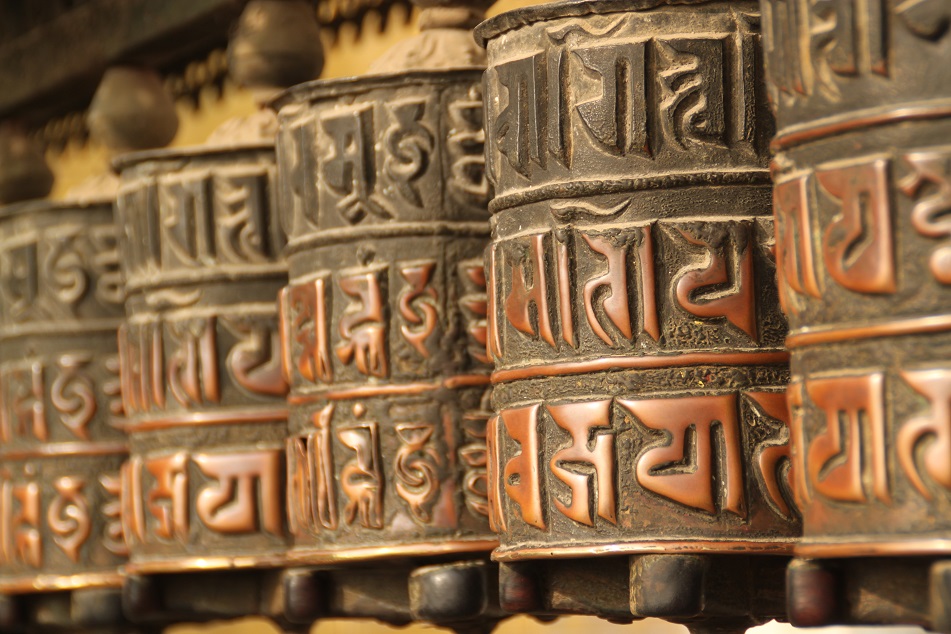
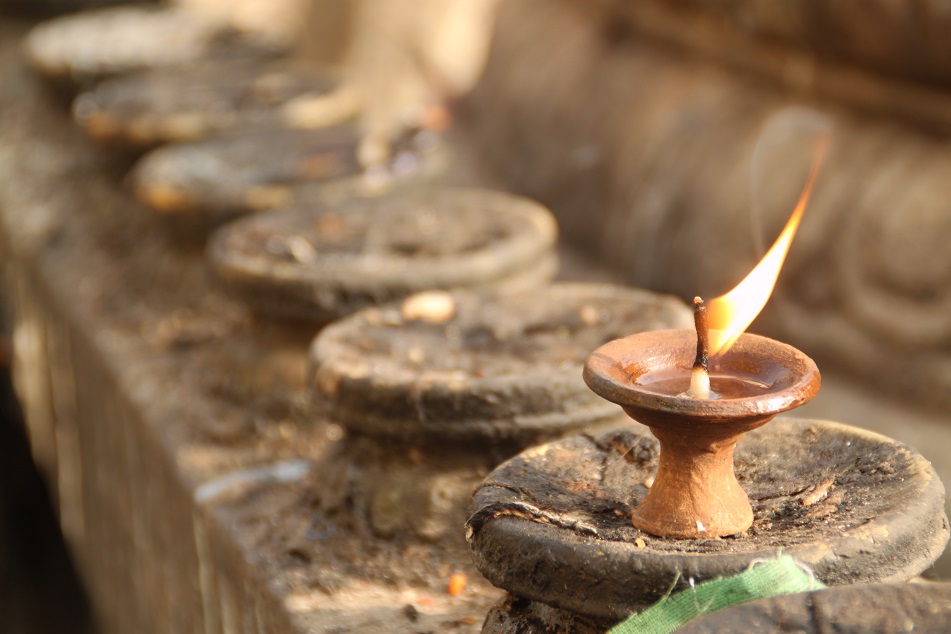
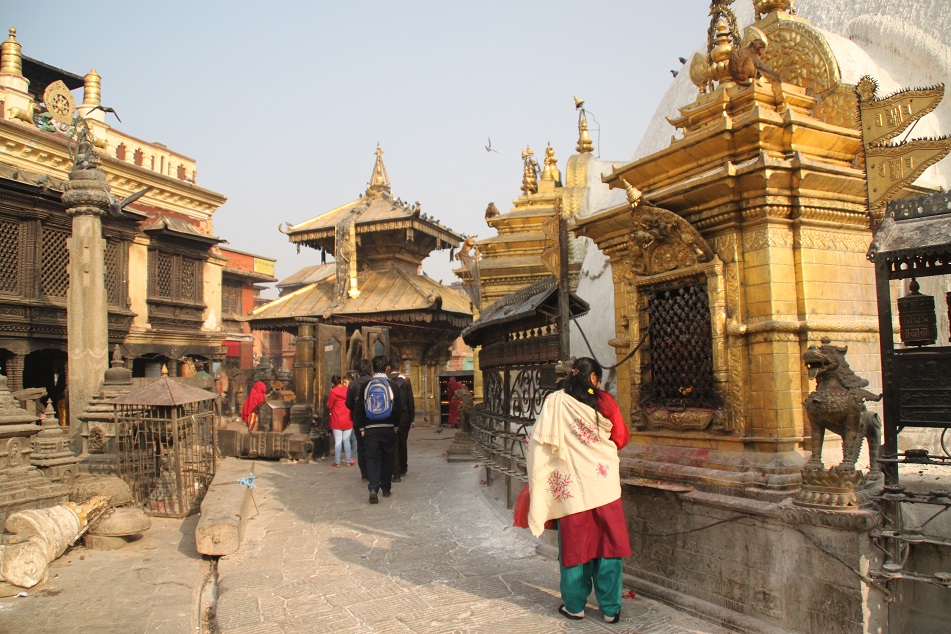
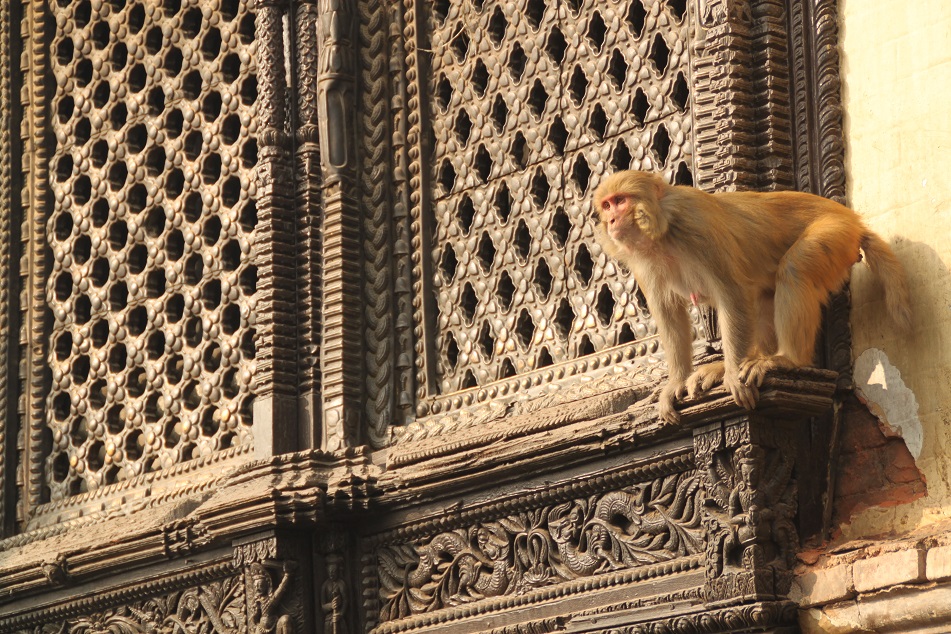
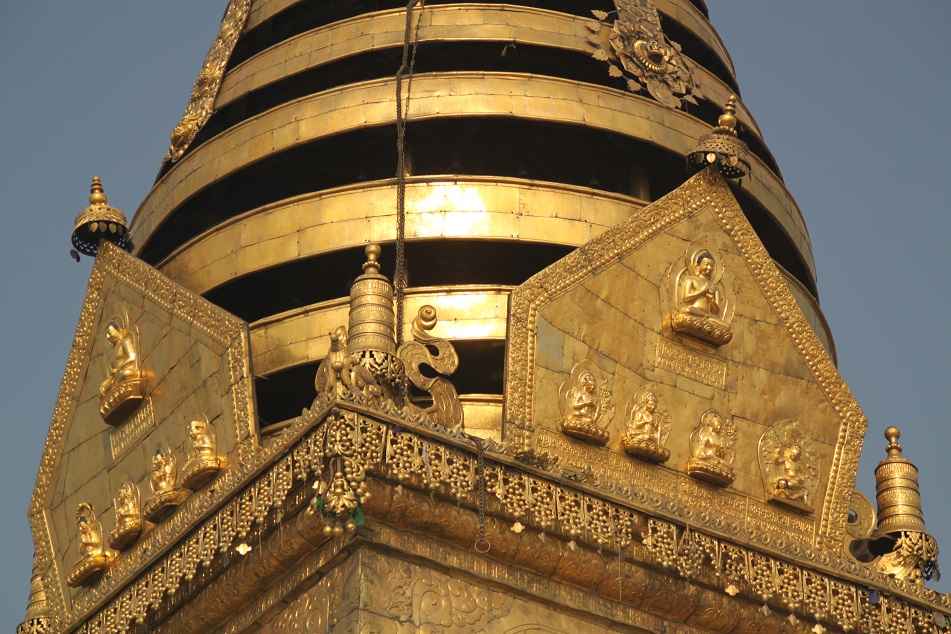
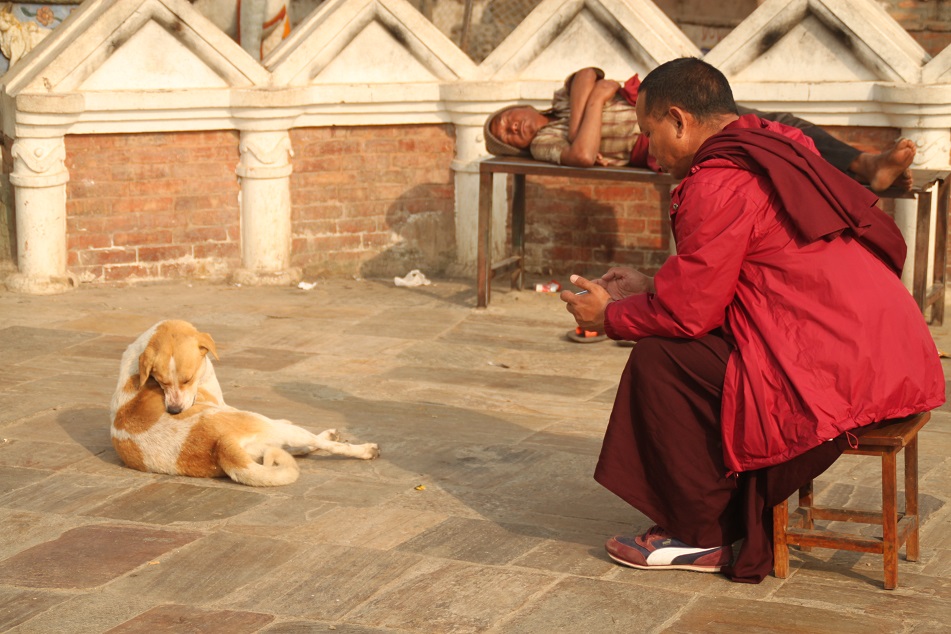
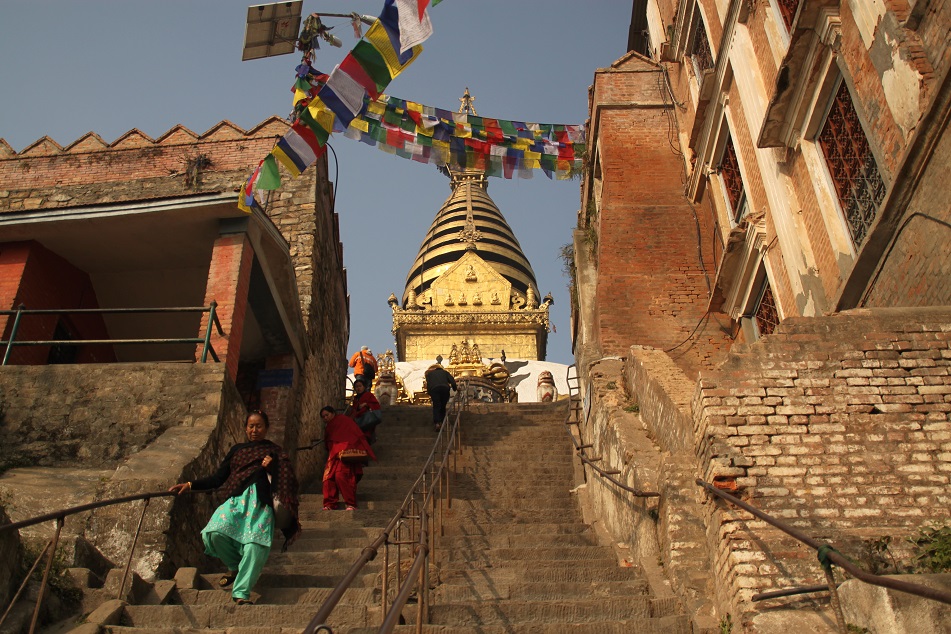
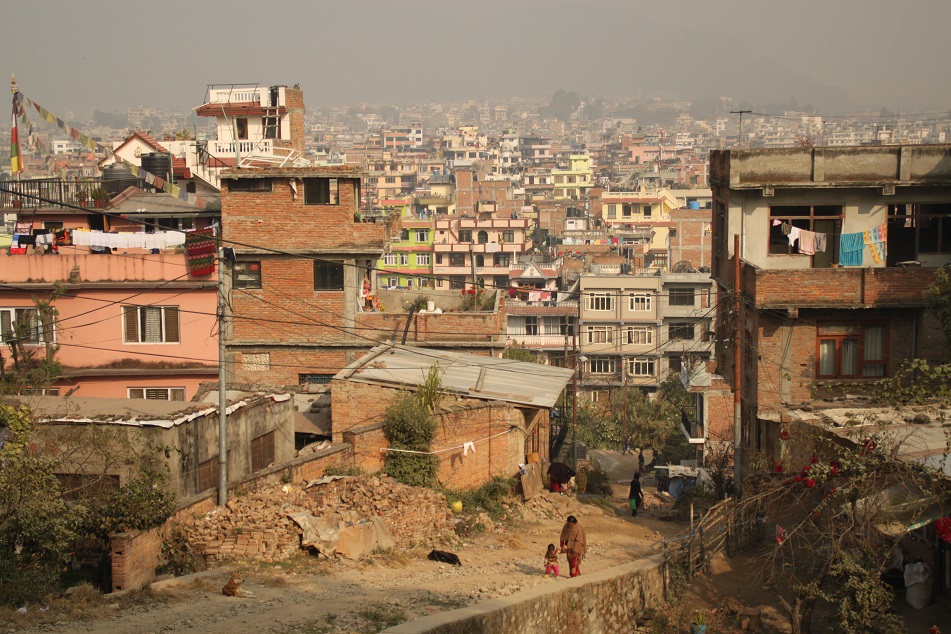
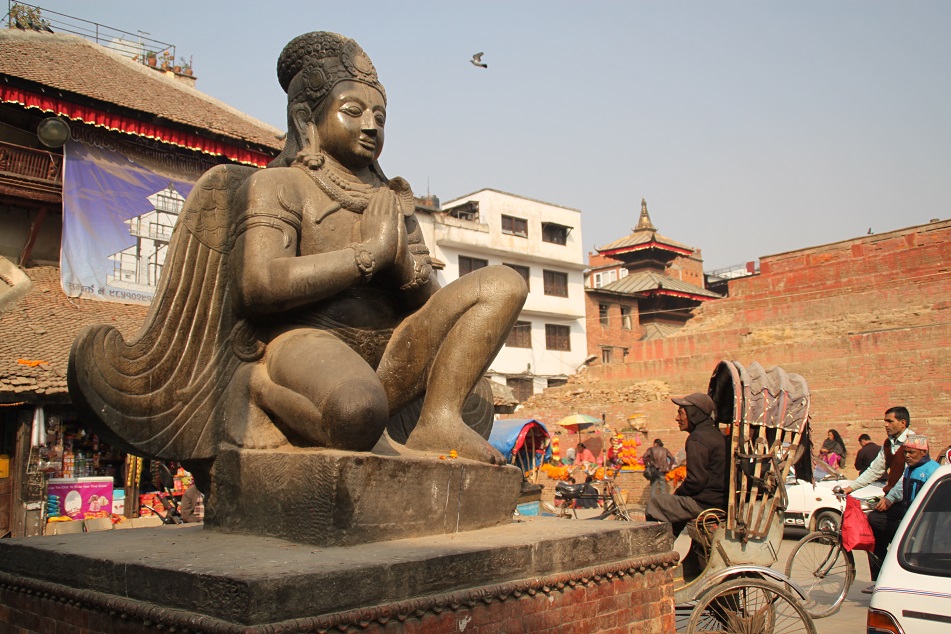
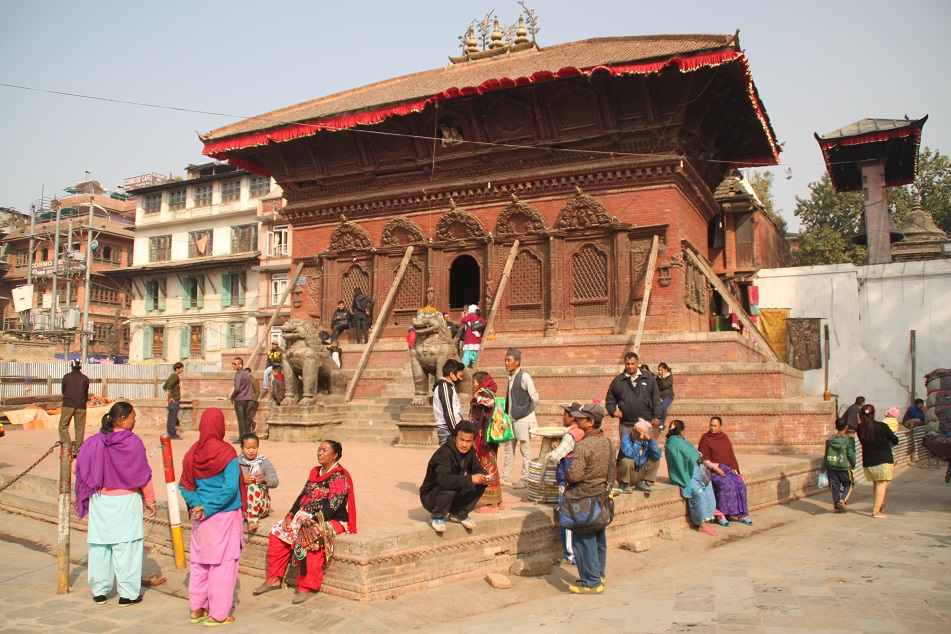


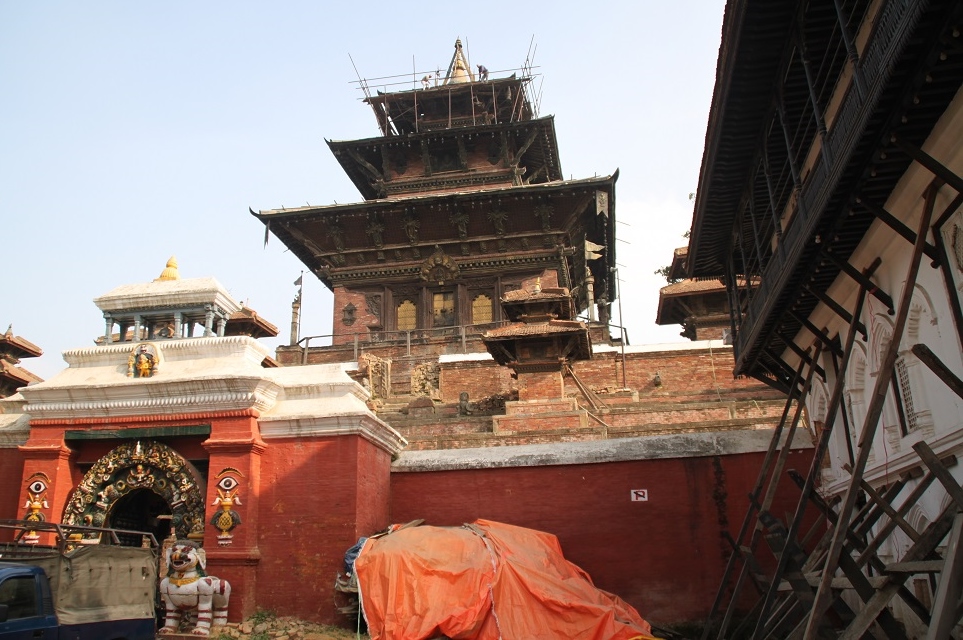
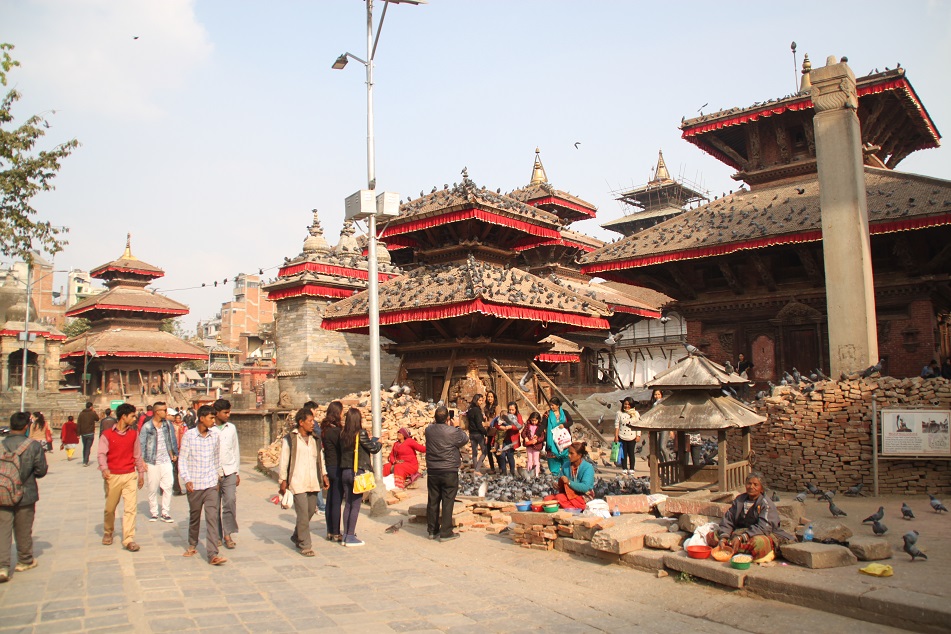


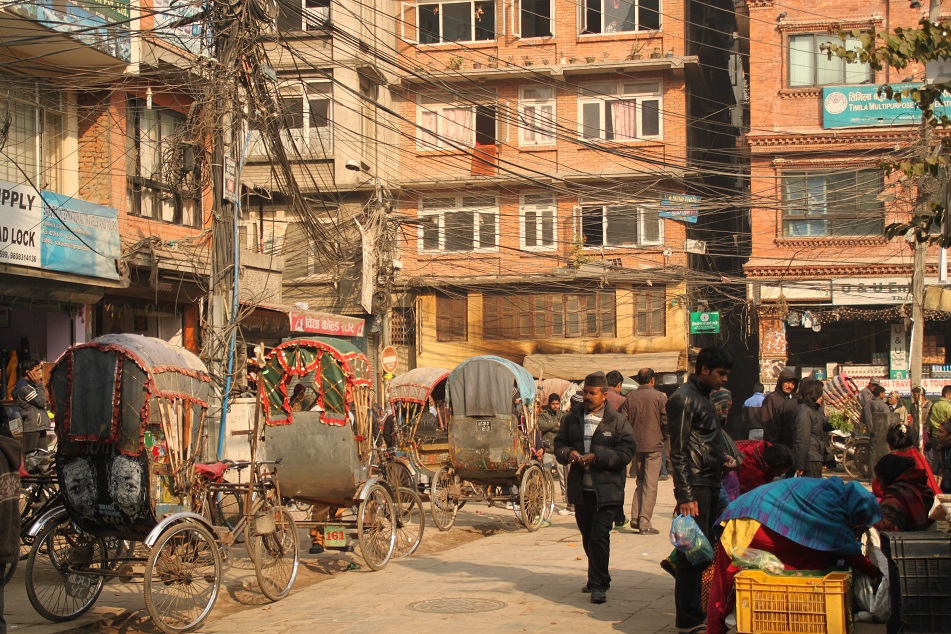
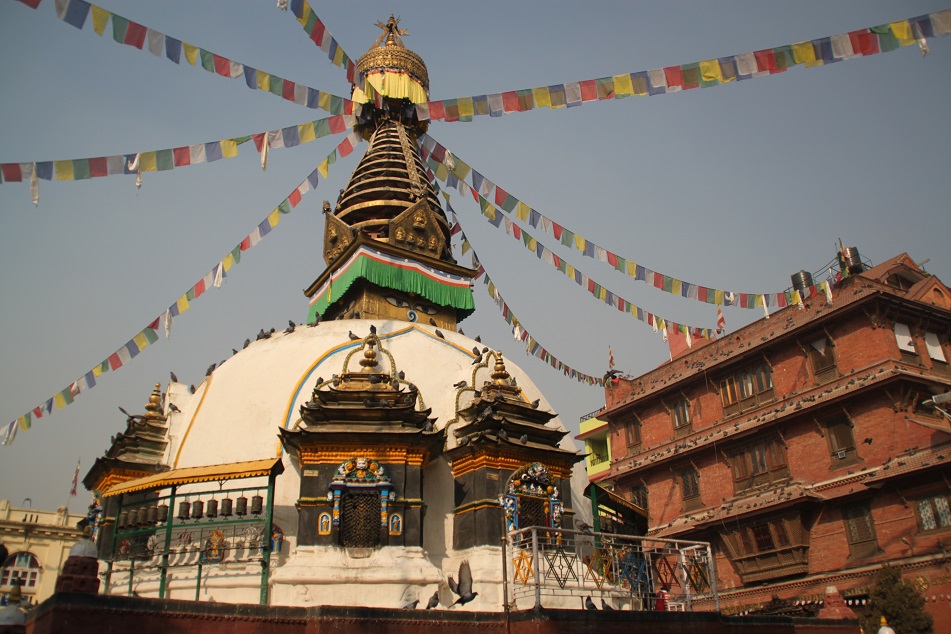
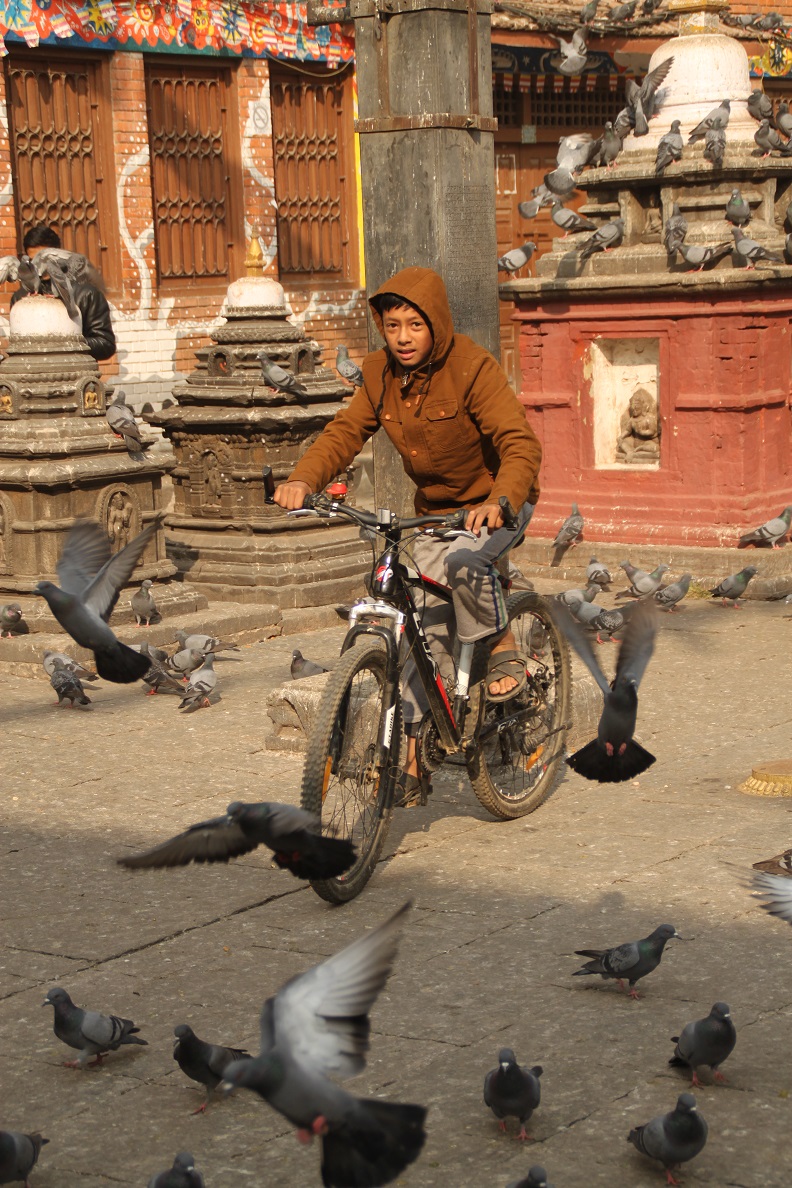
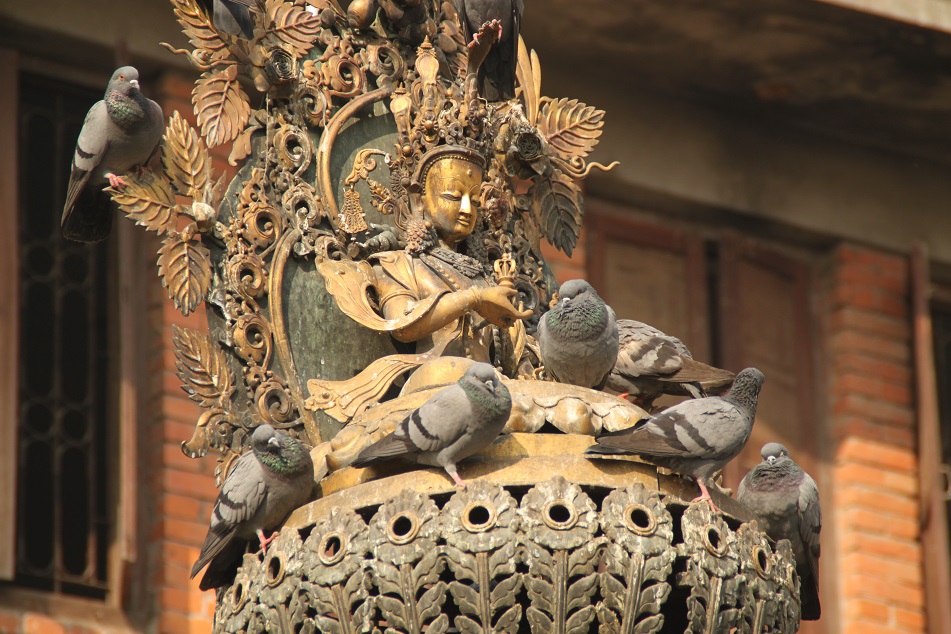
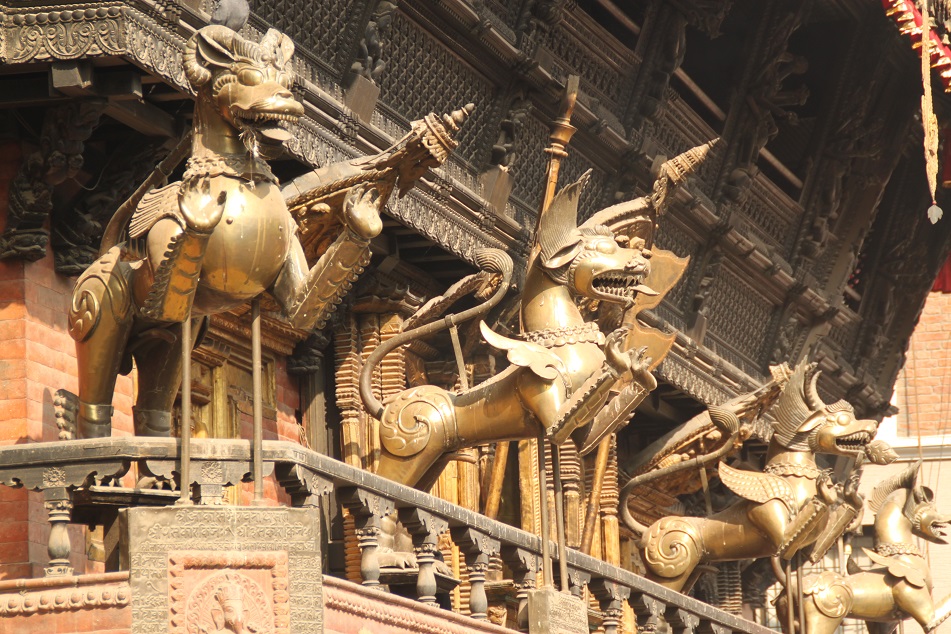
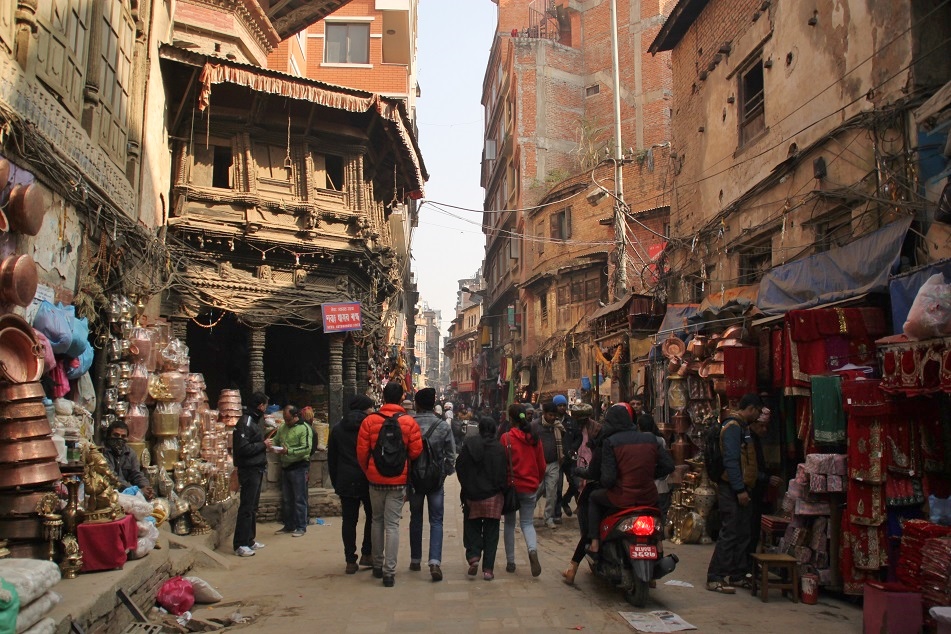
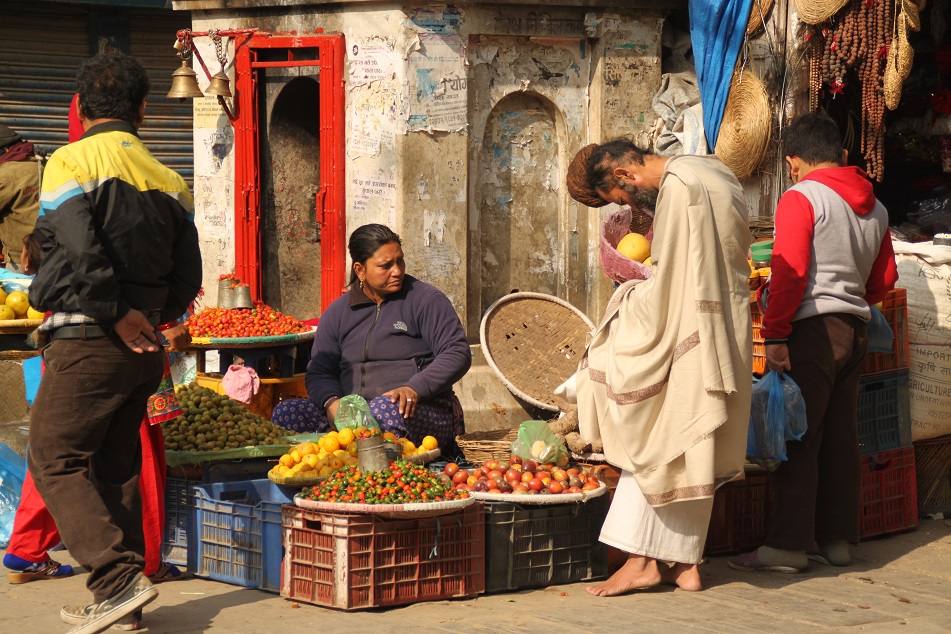

Beautiful
LikeLiked by 1 person
Beautiful might not be a word Kathmandu is often associated with, but I find the city to be just that, in its own way.
LikeLiked by 2 people
Very interesting to me it is 🙂
LikeLike
Amazingly beautiful Pictures!
and wonderfully written!
How deep u have explored and researched Ktm! I admire that.
Also equally u r so good at presenting it fiercely!
It looks like…it is a part of ur upcoming book!
All the very best for soooo beautiful work!
Have a lovely day!
Keep writing : )
keep travelling!
Wishes n sunshine!
–Jyotee
LikeLiked by 2 people
Hi Jyotee. Thank you very much for your kind words. I loved Kathmandu, in spite of its pollution, chaotic streets, and this persistent souvenir vendor I met at the Durbar Square. I was in the city in the middle of the fuel crisis, but it didn’t take the charm away from its temples and extraordinarily intricate architectural decorations. Have a nice day too!
LikeLiked by 1 person
aha!
That was a hard time then!
Yah! whole ktm suffered bcoz of some political issues and etc etc!
Eveythin seemed to b difficult!
sorry to kno! u visited then (smiling)
I ve also visited many places in India. paticularly religious sites and loved thm!
Greetings :
LikeLike
India is indeed the place to go for anyone who loves ancient temples. The diversity and intricacy of the architecture are mind-boggling!
LikeLike
Just the way you said it, in spite its pollution, the dusty chaotic streets, Kathmandu has its own charm and the reason we loved it too 🙂
Your photos took me back in time…
LikeLike
So true, Kris. Chaotic streets and pollution are problems shared by many other cities across the globe. But I believe only a few could match Kathmandu’s charm.
LikeLike
It looks absolutely fascinating. I hope I get there one day. Your photos really captured the feeling of the place.
Alison
LikeLiked by 1 person
Alison, I have a feeling that you would enjoy Kathmandu. Its streets and alleys provide endless possibilities of street and architectural photography. Hope you make it to Nepal sooner than later.
LikeLiked by 1 person
The history you describe here is reason enough to visit and explore this beautiful land, and then there is the “There is no better thing than seeing kind and sincere smiles upon arriving to such a chaotic place like Kathmandu.” which will make it difficult to leave 🙂 Your photos match the magic you describe so well. It is the eclectic pieces of Nepal that make it so special. Safe travels Bama ~
LikeLiked by 3 people
Hi Randall. I really felt at home in Nepal, thanks to the kindness of the locals. It’s really sad that those gentle and friendly people in fact live in one of the poorest countries in Asia. But they’re surely tough people; they’ve endured so much hardship in recent years alone. Nepal is one of those countries I would go back in a heartbeat. Thanks for reading, Randall, and safe travels too!
LikeLike
Bama your description of the crowded streets transported me . I hope one day we will experience it for ourselves. I noticed that this set of photos included som animals, not something I recall seeing too often in your images. I loved them!
LikeLiked by 1 person
Sue, I guess it would be quite a challenge to ride a bicycle in Kathmandu unless you’re used to navigating narrow streets with so many people at the same time. 🙂 Ha, you noticed the lack of animals (and people) in most of the photos from my previous posts. I believe it was partly because in general I felt less intimidated when I tried to take photos of people in Kathmandu (and other places in the country). Thanks Sue!
LikeLike
Menurutku Nepal ini negara yang ‘anomali’. Melihat alamnya yang keras, kemiskinan yang luas, dan angka pengangguran yang tinggi (40%, mengutip tulisanmu di atas) secara logika akan membuat penduduknya ‘keras’ karena mereka harus bersaing untuk bertahan hidup. Tapi yang terjadi justru sebaliknya, penduduk Nepal justru luar biasa ramah. Mulai dari di perkotaan hingga di pedesaan, termasuk daerah-daerah terpencil di pegunungan. Mereka selalu terbuka kepada setiap pengunjung, dan bersedia menolong dengan tulus.
Suatu ketika aku melintas di sebuah desa (antara Jhinu Danda dan Chhomrong, di jalur Annapurna), aku melihat seorang pemuda cacat yang menggantungkan diri pada kursi roda untuk mobilitas di sekitar rumahnya. Bukannya mengemis, pemuda ini justru berjualan di depan rumahnya, menjual minuman dan makanan bagi para pendaki yang kelelahan di tengah jalan. Aku menemuinya sewaktu naik dan turun kembali dari Annapurna Base Camp. Dia menyapa kami yang lewat dan singgah dengan ramah. Salut dengan semangatnya!
Hal-hal sederhana tapi luar biasa macam ini, yang membuat aku selalu kangen dengan Nepal. Keramahan, kesederhanaan, ketulusan, dan semangat mereka menjalani hidup luar biasa.
LikeLike
Naah, setuju! Biasanya ketika penduduk di suatu tempat cenderung keras dan kurang ramah seringkali kita berusaha memakluminya dengan melihat dari latar belakang ekonomi daerah tersebut. Tapi Nepal memang anomali. Setauku Nepal itu salah satu negara termiskin di Asia, dan salah satu paling korup juga. Ditambah dengan cobaan bertubi-tubi yang mereka alami, mulai dari gempa bumi sampai krisis energi, masyarakat di sana tetap ramah dan murah senyum. Bener-bener bikin aku merasa di rumah. Ada sih satu dua yang mencoba mencari peruntungan dengan cara yang agak maksa atau gak ngenakin, tapi itu jumlahnya dikiiit banget dari pengalamanku.
Wah salut sama semangat pemuda itu. Mulia banget niatnya untuk mencari nafkah dengan berjualan dan bukan meminta-minta. Ahh Nepal memang unik, menarik, dan berkesan banget.
LikeLiked by 1 person
Menyoal tentang angka korupsi yang cukup tinggi di Nepal, anehnya banyak ongkos yang berhubungan dengan pariwisata justru ditetapkan secara standard dan pasti.
VISA nya jelas dan pasti, bayar segitu dan gak dimintain tips. Permit untuk trekking juga begitu, ditulis segitu dan petugasnya gak minta ini itu, dan tanpa uang ini itu pelayanannya tetap memuaskan. Bahkan sampai harga makanan di sepanjang jalur Annapurna yang aku lalui kemarin, harganya standard, sudah ditetapkan oleh badan khusus. Kita gak perlu nawar, dan gak perlu takut kalau harganya dimainin. Ini anomali lainnya lagi.
Kayaknya susah untuk gak merasa seperti di rumah, selama berada di Nepal. Gak aneh, kalau banyak orang yang mengunjungi Nepal berulang kali.
Aku aja masih minat balik lagi 😀
LikeLike
Semoga biaya yang standar dan pasti itu memang sebagian besar ditujukan untuk masyarakat setempat ya. Ngomong-ngomong soal makanan di sana, kayaknya aku hampir gak pernah makan yang gak pas di lidahku deh. Meskipun lumayan sering makan dal bhat, tapi anehnya aku gak bosen tuh.
Aku pengen juga sih suatu saat nanti balik lagi ke Nepal, menyusuri jejakmu di ABC. 😀
LikeLiked by 1 person
Amiin, semoga begitu Bam. Iya, soal makanan aku setuju banget, jarang aku nemu masakan yang gagal di lidah selama di Nepal. Itu juga termasuk masakan-masakan yang dijual di lodge sepanjang jalur Annapurna, semua enak.
Amiiin, aku doain tercapai Bam untuk dirimu trekking ke ABC.
LikeLike
Dal bhat, momo, sama masala tea ala Nepal itu favoritku selama di sana.
Amiin, mudah-mudahan suatu hari nanti.
LikeLiked by 1 person
Itu enak semua 🙂
LikeLike
For us, Kathmandu is mostly about dust in the dry season and mud in the rain. But it is also a city of temples and wonderful architecture. Kathmandu is not just the Durbar Square, and I guess Bama is coming up with more.
LikeLiked by 2 people
Kathmandu is the most beautiful city , I ve ever visited!
I agree with u Ankit! that it is a bit populated at the centre and the American life style!! which makes people a bit loner!
But see!
Ktm has so beautiful n favourable climate!
The hills at all sides and the greenery around, makes it like a little heaven!
There is no comparison wen it comes to temples- arts- architectures -history n wonderful people around!
I feel amazed and happy abt Bama’s exploration! abt ktm.
yah! there are lots of other places as well inside the valley! which r wonders! : )
Truly, Earth is a lovely place my friend!
I m sure the other planets out there must envy us! (Smiling)
Cheers!
💕
✌
LikeLiked by 2 people
The temples and culture of the Kathmandu Valley were some of the most exquisite I’ve ever seen and experienced. I mean, I grew up in Java and have been to Bali several times, and both places are known to have sophisticated culture and beautiful vernacular architecture. Even so, I was blown away by all the ancient cities in the Kathmandu Valley.
LikeLiked by 1 person
While I adore Kathmandu for its beauty and culture (eastern mingled with western) I should not deny the fact that it could be more beautiful if we could manage it well. That’s what I am pointing out.
LikeLiked by 1 person
Indeed!
U r ryt my friend!
I agree with your point! yeah:! it cud have need more beautiful and more managed!
let’s hope for the best : )
cheers!
✌
LikeLiked by 1 person
Expect so!
LikeLiked by 1 person
I can see why many people think of the dust (and pollution) when they think of Kathmandu. However to me it’s one of those places where its beauty is so extraordinary that its problems will not take away its charm. Thanks for reading Sandeept.
LikeLiked by 1 person
That’s what Kathmandu is about, Bama. Bhanubhakta said about 150 years ago that Kathmandu is comparable with Alakapuri, the capital of Swarga (Heaven). We have polluted it and I believe if we can control pollution, it will be even more charming.
LikeLike
Hi bama, thanks again for your wonderful post…while i have been to kathmandu a number of times over the last 30 years there is still more to learn….i loved getting lost and then finding my way 😊 namaste from Trees
LikeLiked by 1 person
Thank you for reading, Trees. Getting lost in Kathmandu is probably the best way to get to know the city and its fascinating corners. I would love to return to the city one day and explore more of its ancient temples. Namaste! 🙂
LikeLiked by 1 person
Ah Bama, melihat foto Garuda itu aku kesemsem banget. Mengingatkan aku akan kejadian2 manis dan luar biasa disana hihihi.. Garuda itu kan di depan Trailokya Mohan Narayan trmple sebelahan dg istana dewi kumari kan?
Dan kenapa sama ya waktu saya get lost (walaupun ga heboh2 amat siiiy) saya juga liatin itu kabel2 listrik yang kayak spaghetti hahaha…
Daaan… dal bhat itu emang enak banget kok. Aku makan di tempat keren, di tempat biasa, di warung murahan, sama enaknya lho dan emang ga bosenin… pas gitu di lidahku. Aku sendiri bingung karena aku jarang banget bisa cocok dg makanan lokal. Baru di Nepal itu (kecuali thailand ya) aku jd suka makan hahaha…
LikeLike
Yes, bener banget mbak. Wuih, ada kejadian manis apa mbak di sana? Apa udah pernah ditulis di blog Mbak Riyanti tapi saya kelewatan baca ya?
Nah, saya itu sebenernya cukup suka sama makanan India yang pernah dicobain di sini, Malaysia, dan waktu ke Inggris dulu. Tapiii pas di India kok malah cepet bosen (kecuali di Goa dan Kerala yang makanannya lebih masuk ke lidah saya). Sampe-sampe pas di Pondicherry saya sama James nyari makanan non-India saking bosennya. 😀 Nah pas di Nepal itu salah satu yang bikin saya jatuh cinta banget selain karena bangunan-bangunan bersejarahnya yang cantik banget dan orang-orangnya yang sangat ramah, makanannya enak di lidah. Bumbunya pas, gak hambar tapi juga gak berlebihan.
LikeLiked by 1 person
Bama, yet another amazing piece. It is amusing to see how chaotic Kathmandu is and yet in the middle of all its beautiful mess you can find temples with long history and gorgeous statues. I think I would be a little overwhelmed by it all but at the same time mesmerized. Such a complex yet beautiful place!
LikeLiked by 1 person
Thank you, Aggy. Usually I don’t really like crowded and chaotic places, but somehow Kathmandu was different. It has clearly cast its spell on me. It can be quite overwhelming, I admit, but at the same time mesmerizing, as you said.
LikeLike
Amazing
LikeLike
Thank you. Kathmandu was such a photogenic city.
LikeLiked by 1 person
This post melts my heart. We were there — almost all the places you’ve shown — about 3 years ago. I have wondered so long what has become of the temples destroyed or damaged in the earthquake. Your pictures speak volumes. Thank you, thank you.
LikeLike
Hi Rusha. I would say based on my observation Kathmandu suffered the most damage compared to Bhaktapur and Patan. But the three ancient cities were as charming and fascinating as they were centuries ago, I believe. Thank you for reading.
LikeLiked by 1 person
beautiful pictures, this reminds me of my trip to Tibet.
LikeLike
Thank you, Liz. Tibetan Buddhism has a big influence in Nepalese culture, so that and those Tibetan temples will remind anyone of Tibet.
LikeLiked by 1 person
Such a crazy yet fascinating place – you’ve done it justice here! Why were there no prayer flags at Swayambhunath?
LikeLike
That reminds me of your post on Kathmandu. Such a crazy and fascinating place it really was. I’m not exactly sure why the flags were taken down, but I assume it had something to do with the restoration work at the temple. I could still see the flags though, but not at their usual place. Thanks Lex!
LikeLiked by 1 person
I loved Kathmandu, Bama. In spite of the grime and pollution, I found so much beauty in its colourful streets and denizens. You have so many wonderful shots in this post – my favourite is the one of the boy on a bicycle at Shree Gha. The moment was captured so well, and he seems to be looking straight at the camera with a mixture of curiosity and surprise.
LikeLike
I couldn’t agree more, James. Kathmandu and other ancient cities in the valley are among the most impressive and unforgettable places I’ve ever visited by far. Thanks James! I had to wait for that boy to circle the stupa several times before getting that moment I wanted. Thanks for finding Shree Gha at the first place!
LikeLiked by 1 person
The pictures are amazing!!!
LikeLike
Thank you very much for your kind words, Marta. Glad you liked them. 🙂
LikeLike
Wow…both the words and the photos are fantastic. I almost feel like I saw it with my own eyes.
LikeLike
Hi Kristina. Thank you for reading and for leaving such a kind comment. Really appreciate it! You live in a beautiful country yourself. I have never been to Slovenia but so far I have never heard any bad things about it.
LikeLiked by 1 person
For a visitor Slovenia is truly beautiful. For a person living there it’s…like every homeland – full of issues and reasons to get mad about 😉
LikeLike
It’s the same with many other places. 🙂
LikeLiked by 1 person
I agree with the first comment: “Beautiful” even though you’re right…not the usual adjective to most. But to me…yes, eye of the beholder and all that, eh? Your photos again are outstanding, love the one of the window without equal. And I think I took the same photo of the alley with all those electric wires! It would just be lovely if the world decided to help this place out.
LikeLike
Kathmandu is beautiful in its own way. Not gentrified beautiful like many other cities in the world, but chaotic beautiful, I’m sure you know what I mean. Thanks Badfish! I took sooo many photos in Kathmandu, Bhaktapur, Patan and Kirtipur — they were all so fascinating and pretty. That window without equal really is one of its kind, and I’m glad I found out about it on the internet before exploring the Durbar Square. Yes, Kathmandu, and Nepal in general, really need the world’s help, regardless the resilience of its people. They deserve better lives.
LikeLike
hey I just noticed you have 40000 followers! are you like the “Follower Whisperer” or what…how do that many people even find you???
LikeLike
Haha! Follower Whisperer, that’s funny. 😀 To be honest, I don’t know the answer to your question. However there was a time when WordPress had ‘Recommended Blog’ and I was featured in the Travel section. That helped people find my blog, I guess.
LikeLike
I just wanted to let you know how inspiring I find your blog. I myself am travelling to Southeast Asia in a few weeks and one day soon hope to visit Nepal. Your writing is lovely and I’m glad I found it. Thank you for writing this blog!
LikeLike
Thank you for dropping by and leaving such a kind comment. I wish you a very enjoyable and unforgettable journey across Southeast Asia, and try to sample as many local dishes as possible! 🙂
LikeLiked by 1 person
Oh you certainly portray a beautiful Khatmandu Bama! I love everything that I see here: simian residents, crowded alley and all. And I love the emphasis on eyes in their religious art. Thanks for the virtual tour.
LikeLike
*Kathmandu!
LikeLike
Beauty in chaos, Kathmandu really was. You would certainly enjoy the exquisite wood carvings and architectural style, Madhu.
LikeLike
It looks too real to be true, if that makes any sense. There’s so much stimuli, a feast for the senses.
LikeLike
The world is indeed filled with many extraordinarily astounding places, Julie. Just last night I watched about an ancient Buddhist site still under excavation in Afghanistan. It shows that discoveries are still to be made even today with the help of modern technology.
LikeLike
Aku suka sekali tulisannya. Kemarin aku liburan lebaran di Nepal dan main ke tempat-tempat atraktif seperti yang Mas Bama tulis. Tapi kemarin gak sampe masuk ke Kathmandu Durbar Square karena tiketnya mahal hahaha. Aku jadi kangen makan buff momo.
LikeLike
Terima kasih Justin. Wah semoga lain kali kalau ke Kathmandu bisa mengunjungi Durbar Square-nya ya, soalnya worth the entrance fee banget. Ahh saya jadi kangen buff momo juga nih.
LikeLike
Enjoyed
LikeLike
Mas Bamaaaa, tanya dong, tanya lokasi persisnya Desay Madu Jhya dong… Sama fotonya Vejrasattva ngambilnya dimana itu? Keren abisz deh… Rasanya udah keliling Kathmandu, tetapi kok banyak yang ga tau juga ya? Ampunn deh, kayaknya kudu balik lagi demi Jujudhau qiqiqiq…
LikeLike
Desay Madu Jhya ini persis di ujung sebelah barat Durbar Square deh seinget saya. Jadi kalau masuk ke Durbar Square lewat barat, biasanya bakal lewat satu jalan utama di situ. Nah gak jauh sebelum belok ke Durbar Square ada satu bangunan kecil tempat Desay Madu Jhya ini berada. Nah kalau patung Vajrasattva itu ada di kompleksnya Shree Gha, jalan agak jauh dikit dari Durbar Square ke arah utara. Tapi kalau saya ke Kathmandu lagi belum tentu bisa nemu sih, soalnya jalanannya kan kayak labirin, hehe. Naaah, bener itu. Juju Dhau memang ngangenin!
LikeLiked by 1 person
Hihihi makasiii banyak ya mas. Informasinya berguna walaupun kayaknya sih nyasar udah pasti, apalagi buat aku hahaha.
LikeLike
Sama-sama Mbak. Tapi kayaknya nyasar di Kathmandu itu sebuah keniscayaan deh. 😀 Saya pernah suatu hari jalan sendiri dari Durbar Square menuju hotel. Ehhh, gara-gara salah belok beberapa kali jadinya nyasar jauuuuh banget. Akhirnya saya bener-bener hapalin di belokan ini ada toko apa, di belokan selanjutnya ada kuil bentuknya gimana, dst.
LikeLiked by 1 person
Hahahaha mas Bamaaaa…. orang sehebat mas Bama aja nyasarnya dah ribet kayak gitu, gimana saya yaa.. bisa mbulet dan ga sadar udah mbulet gitu hahaha… tp beneran ini jd warning utk jalan di ktm soalnya dulu kan aku ga ngalamin mblusukan.
LikeLike
Duh mbak, saya itu tukang nyasar lho. Waktu pertama kali ke Bangkok nyasar, pertama kali ke Kandy nyasar, di Manila pun nyasar. Biasanya setiap saya nyasar alhasil saya harus jalan kaki berkilo-kilo jauhnya sampe ketemu tempat yang saya mau tuju (atau sampe saya nyerah kayak waktu di Kandy). Tapi beruntung sekarang ada Google Maps, jadi sebelum jalan bisa cek dulu belok kanannya berapa kali, kiri berapa kali, dst. 🙂
LikeLiked by 1 person
Pingback: Pokhara: Beyond the Hiking Trails | What an Amazing World!
Thanks for the memories. The City is very polluted and much more croweded than when I visited.
LikeLiked by 1 person
When did you go to Kathmandu? I loved the city so much I would go in a heartbeat if I get the chance.
LikeLike
What did you like about it the most?
LikeLiked by 1 person
I loved the Newari architecture (which the city shares with Patan and Bhaktapur), the local food, and the friendly people (I came to Nepal right after traveling for a month in India which at times was quite intimidating).
LikeLiked by 1 person
What was intimidating about travelling in India? ( I agree with you about Kathmandu – I loved the architecture).
LikeLike
A few examples:
1. When I was in Goa and asked the hotel owner where the nearest convenience store was, he replied tersely “What do you need?” He could have just told me where it was.
2. In a small city in Tamil Nadu, a young woman approached me asking for donation for handicapped children. When I declined politely and walked away, she hit me with a laminated paper she was holding. “Handicapped children! handicapped children!”
3. When I took a rickshaw in Kerala, the driver was very pushy. He insisted on taking my friend and I to so many shops although we said we didn’t want to. In the end, he “threatened” us a little bit, telling us to follow wherever he took us.
But of course, we met friendly and hospitable Indians as well, including our host in Kochi and our blogger friend in Chennai. India was really “in your face”, although our experience won’t deter us from returning one day.
LikeLike
I was there in 1986.
LikeLiked by 1 person